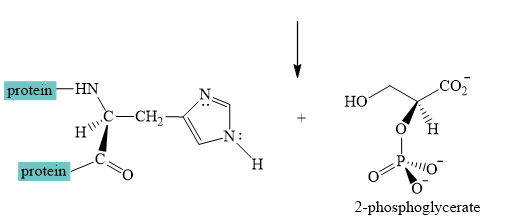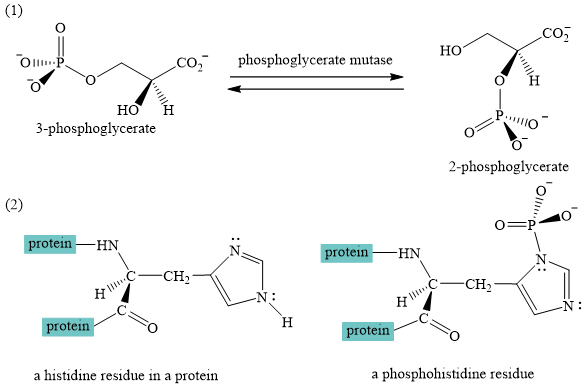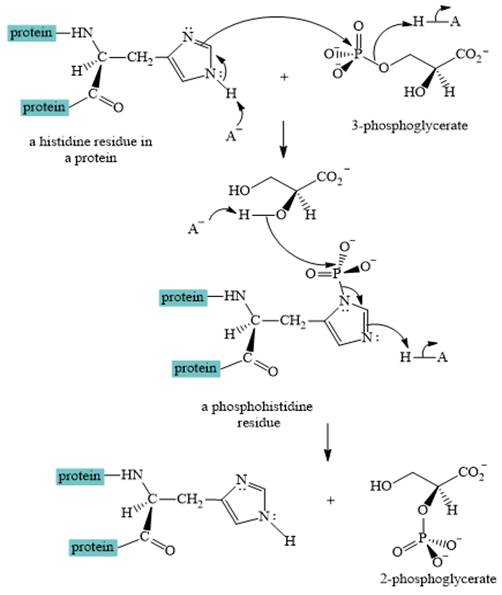
(a)
Interpretation:
A curved-arrow mechanism for the interconversion of 3-phosphoglycerate to 2-phosphoglycerate is to be drawn.
Concept introduction:
The interconversion of 3-phosphoglycerate to 2-phosphoglycerate is carried by enzyme catalysed nucleophilic substitution. The nitrogen of histidine residue in a protein acts as a nucleophile whereas the phosphorus of phosphate ester acts as an electrophile.
Answer to Problem 25.35AP


Explanation of Solution
The interconversion equation of 3-phosphoglycerate to 2-phosphoglycerate and the structures of histidine and phosphohistidine residue is shown below:

A curved-arrow mechanism for the interconversion of 3-phosphoglycerate to 2-phosphoglycerate is shown below:

The nitrogen of histidine residue acts as a nucleophile after loss of proton by a base A- and forms substitution product with inversion of configuration at phosphorous. In second step the nucleophilic attack of oxygen from acetate group gives 2-phosphoglycerate where the configuration at the phosphorous reverts back to original.
The two step curved arrow mechanism for the interconversion of 3-phosphoglycerate to 2-phosphoglycerate is drawn.
(b)
Interpretation:
If the isotopically chiral 3-phosphoglycerate formed would have the same configuration, the opposite configuration, or equal amounts of two configurations at phosphorus when an enantiomerically pure 2-phosphoglycerate derivative containing isoptopically chiral phosphate group is converted to 3-phosphoglycerate is to be determined.
Concept introduction:
The enzyme catalyzed substitution reaction of phosphate ester derivate at phosphate proceeds through SN2 reaction with inversion of stereochemistry. If substitution occurs twice that is with double inversion results in retention of stereochemistry.
Answer to Problem 25.35AP
If enantiomerically pure 2- phosphoglycerate is subjected to this reaction, the isotopically chiral 3- phosphoglycerate formed would have the same configuration at phosphorous.
Explanation of Solution
The enzyme catalyzed substitution reaction of phosphate ester derivate at phosphate proceeds through inversion of stereochemistry. The substitution occurs twice with double inversion of the product formed with retention of configuration. Thus, if enantiomerically pure 2-phosphoglycerate is subjected to this reaction, the isotopically chiral 3-phosphoglycerate formed will have the same configuration at phosphorous.
The interconversion of 2-phosphoglycerate to 3-phosphoglycerate by enzyme catalysed substitution occurs with retention of stereochemistry at phosphorus.
Want to see more full solutions like this?
Chapter 25 Solutions
Organic Chemistry, Ebook And Single-course Homework Access
- Identify and provide a concise explanation of the concept of signal-to-noise ratio (SNR) in the context of chemical analysis. Provide specific examples.arrow_forwardIdentify and provide a concise explanation of a specific analytical instrument capable of detecting and quantifying trace compounds in food samples. Emphasise the instrumental capabilities relevant to trace compound analysis in the nominated food. Include the specific application name (eg: identification and quantification of mercury in salmon), outline a brief description of sample preparation procedures, and provide a summary of the obtained results from the analytical process.arrow_forwardIdentify and provide an explanation of what 'Seperation Science' is. Also describe its importance with the respect to the chemical analysis of food. Provide specific examples.arrow_forward
- 5. Propose a Synthesis for the molecule below. You may use any starting materials containing 6 carbons or less (reagents that aren't incorporated into the final molecule such as PhзP do not count towards this total, and the starting material can have whatever non-carbon functional groups you want), and any of the reactions you have learned so far in organic chemistry I, II, and III. Your final answer should show each step separately, with intermediates and conditions clearly drawn. H3C CH3arrow_forwardState the name and condensed formula of isooxazole obtained by reacting acetylacetone and hydroxylamine.arrow_forwardState the name and condensed formula of the isothiazole obtained by reacting acetylacetone and thiosemicarbazide.arrow_forward
- Provide the semi-developed formula of isooxazole obtained by reacting acetylacetone and hydroxylamine.arrow_forwardGiven a 1,3-dicarbonyl compound (R1-CO-CH2-CO-R2), indicate the formula of the compound obtaineda) if I add hydroxylamine (NH2OH) to give an isooxazole.b) if I add thiosemicarbazide (NH2-CO-NH-NH2) to give an isothiazole.arrow_forwardAn orange laser has a wavelength of 610 nm. What is the energy of this light?arrow_forward
- The molar absorptivity of a protein in water at 280 nm can be estimated within ~5-10% from its content of the amino acids tyrosine and tryptophan and from the number of disulfide linkages (R-S-S-R) between cysteine residues: Ε280 nm (M-1 cm-1) ≈ 5500 nTrp + 1490 nTyr + 125 nS-S where nTrp is the number of tryptophans, nTyr is the number of tyrosines, and nS-S is the number of disulfide linkages. The protein human serum transferrin has 678 amino acids including 8 tryptophans, 26 tyrosines, and 19 disulfide linkages. The molecular mass of the most dominant for is 79550. Predict the molar absorptivity of transferrin. Predict the absorbance of a solution that’s 1.000 g/L transferrin in a 1.000-cm-pathlength cuvet. Estimate the g/L of a transferrin solution with an absorbance of 1.50 at 280 nm.arrow_forwardIn GC, what order will the following molecules elute from the column? CH3OCH3, CH3CH2OH, C3H8, C4H10arrow_forwardBeer’s Law is A = εbc, where A is absorbance, ε is the molar absorptivity (which is specific to the compound and wavelength in the measurement), and c is concentration. The absorbance of a 2.31 × 10-5 M solution of a compound is 0.822 at a wavelength of 266 nm in a 1.00-cm cell. Calculate the molar absorptivity at 266 nm.arrow_forward
 Chemistry for Today: General, Organic, and Bioche...ChemistryISBN:9781305960060Author:Spencer L. Seager, Michael R. Slabaugh, Maren S. HansenPublisher:Cengage Learning
Chemistry for Today: General, Organic, and Bioche...ChemistryISBN:9781305960060Author:Spencer L. Seager, Michael R. Slabaugh, Maren S. HansenPublisher:Cengage Learning Organic ChemistryChemistryISBN:9781305580350Author:William H. Brown, Brent L. Iverson, Eric Anslyn, Christopher S. FootePublisher:Cengage Learning
Organic ChemistryChemistryISBN:9781305580350Author:William H. Brown, Brent L. Iverson, Eric Anslyn, Christopher S. FootePublisher:Cengage Learning
 Macroscale and Microscale Organic ExperimentsChemistryISBN:9781305577190Author:Kenneth L. Williamson, Katherine M. MastersPublisher:Brooks Cole
Macroscale and Microscale Organic ExperimentsChemistryISBN:9781305577190Author:Kenneth L. Williamson, Katherine M. MastersPublisher:Brooks Cole



